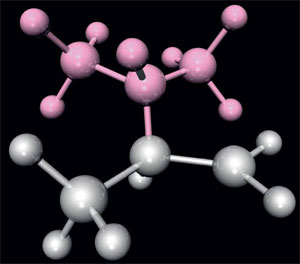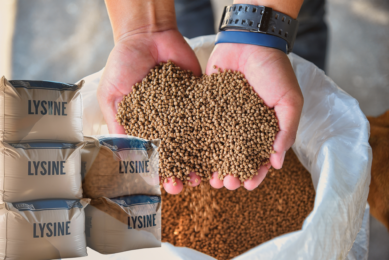Valine: The next limiting animo acid

Research showed that Valine is the next limiting amino acid in pig and poultry diets. The recent introduction of feed grade valine on the market creates further opportunities for feed formulators to decrease crude protein and to increase balanced amino acid profile in animal diets. Etienne Corrent further explains.
By Etienne Corrent
Valine (Val), like Isoleucine (Ile) and Leucine (Leu), is a branched chain amino acid (BCAA). Like Lysine (Lys), Threonine (Thr), Methionine (Met) and Tryptophan (Trp), Val is an essential and indispensable nutrient for pigs and poultry, and it has to be supplied through the diet since it cannot be synthesised by the animal. In European diets, Val is the fifth-limiting amino acid after Trp in pigs, and the fourth-limiting after Thr in broilers, and appears to be a deficient nutrient in regards to the minimum requirements for these species. By adding feed grade Valine, it is now technically possible to formulate diets where six amino acids are co-limiting for performance.
Valine requirements in piglets
Recommendations for the Val requirement given by various national research institutes are presented in Table 1, with an average value of 70% standardised ileal digestibility (SID) Val:Lys. Beside these recommendations, relatively few studies on the Val requirement have been carried out, and only 8 relevant studies have been published since 1970 for piglets (Corrent and Primot, 2009). In addition, there is a large variability in reported requirements between studies due to the different modes of expression. To investigate further the Val requirement in piglets, additional dose-response trials have been carried out by Ajinomoto Eurolysine s.a.s., in collaboration with research institutes all over Europe. A prerequisite to express the Val requirement relative to Lys is to ensure that, in the experimental diets, dietary Lys is the second limiting factor for performance, after Val, and therefore, that no other essential amino acids are deficient (Boisen, 2003). The effect of Val:Lys on average daily gain (ADG) of the selected trials is presented in Figure 1. In most trials, piglets reached their best performance at a ratio between 70 and 75% of SID Val:Lys. For each trial, the Val:Lys requirement determined using statistical models are presented in Table 2.
Experimental results appear to be rather homogeneous with average requirements estimates for average daily gain (ADG), average daily feed intake (ADFI) and feed conversion ratio (FCR) of 71, 73 and 71% SID Val:Lys, respectively. It is concluded that 70% SID Val:Lys is a minimum requirement estimate for piglets.
Valine: a limiting amino acid
Amino acid limitation to animal performance arises from the difference between the amino acid composition of feeds and the animals’ amino acid requirements. For every specie the ranking of limiting amino acids and the possibilities of crude protein reduction depend on the ideal amino acid profile set in the formulation and the feed materials available. Knowing the requirement of Val by piglets, it is possible to evaluate to what extent Val is limiting for piglet growth. For instance, additional trials had been run to determine which of the two amino acids, Val or Ile, was first limiting. Barea et al. (2009a) tested the effect of SID Val and/or Ile as ratios to Lys in 4 diets fed to piglets from 12 to 25 kg. SID Val to Lys ratio was increased from 57 to 70% and SID Ile to Lys ratio from 50 to 60%. It is shown in Figure 2 that ADG was significantly improved by the Val increase (+25%), but no effect of Ile was detected. Valine is therefore limiting before Ile, and Ile requirement may be lower than actual recommendations. This lower Ile requirement (50% SID Ile:Lys) is corroborated by the conclusions of Mavromichalis et al. (1998), Lordelo et al. (2008), and Barea et al. (2009c). More recently, Wiltafsky et al. (2009) proposed an SID Ile:Lys requirement varying from 49 to 54 % when there was no excess of Leu (108% SID Leu:Lys), but this requirement may be higher when Leu is in excess. Indeed, BCAAs share in part a common catabolic pathway, which lead to possible interactions between these amino acids.
Practical implications
In current practical feeds, Val is in general deficient in comparison to the requirement of 70% SID Val:Lys. Therefore, by giving the possibility to cover the need of the piglet, feed use L-Valine permits to enhance piglet performance. Average improvements of ADG and FCR were estimated on the basis of the dose-response trials dataset, and are presented in Figure 3. It can be calculated that, based on today’s practical diets, an increase to 70% SID Val:Lys may lead to 1-2 kg greater weight gain in piglets reared between 12-25 kg over 28 days. Lordelo et al. (2008) studied the effect of the reduction of dietary crude protein (CP) in piglets from 7-23 kg with or without additional L-Valine. The control diet had a high dietary CP level (20.5 %). A reduction of 3.5 percentage points of dietary CP was achievable with the use of L-Valine without detrimental effect on performance (Figure 4). In addition, diarrhoea incidence (Figure 5) and nitrogen excretion were significantly reduced by lowering dietary CP.
Dose response study in broilers
It is reported that Val is a limiting amino acid in wheat or barley based broiler diets (de Blas, 2008) as well as in corn based diets (Fernandez et al., 1994). Recently, Corzo et al. (2007) studied the effect of supplementing a reduced CP corn/soy bean meal based diet with several individual amino acids (L-Val, L-Ile, L-Arg or L-Gly) on broilers performance from 21 to 42 days of age. As a result, the best improvement in performance was obtained with the L-Valine supplementation (Figure 6). In the same study, a dose response to Val:Lys was carried out. Using a curvilinear-plateau model to depict the body weight gain response (Figure 7), the requirement is determined at 81% SID Val:Lys. Same responses were reported for FCR, and breast meat (weight and yield). These results are in agreement with NRC (1994), Mack et al. (1999), Schutte and de Jong (1999) with respective recommendations of 82, 81 and 80 % Val:Lys (SID).
Conclusion
A Val dietary deficiency severely impacts pigs and broilers performance and this essential amino acid must be monitored carefully in industrial feeds.
A minimum of 70% SID Val:Lys is estimated for piglets requirement, and 80% for broilers. Nowadays, the availability of L-Valine feed grade allows fulfilling these requirements without increasing dietary crude protein levels which would be detrimental for health and environment concerns. Moreover, L-Valine gives the opportunity to increase Lys dietary levels while the ideal amino acid profile is maintained resulting in strong improvement in performance. This new tool constitutes a precursor of major changes in animal nutrition and feed formulations practices.
Source: FeedMix vol 17 nr 5, 2009











